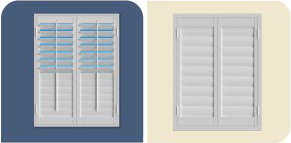
3 Ways Polywood Shutters Are A Better Choice Than Hollow Vinyl And Composite Shutters In Chicago, IL
December 15, 2015
Wherever you look in Chicago, there are plenty of plantation shutters choices. And when you are figuring out which non-wood shutter is best for you, some differences may be tough to recognize. You can pick the wrong type without knowing and find yourself purchasing low quality shutters. Wondering if Polywood® shutters - our best-selling solid polymer shutters - are a better value than composite shutters? Here are three ways Polywood shutters are better than composite shutters in Chicago, IL .
1. Polywood vs Composite Shutters Durability
Polywood shutters are constructed from a first class solid polymer that results in the most color-retention, durability, and rigidity than any other shutter on the market. This means the shutter louvers will not chip as long as they’re on the window. In contrast, composite shutters are built from a pressed-board core, encapsulated in poly-vinyl. The vinyl wrapping the pressed board is likely to peel off from the core element easily. And this peeling is expedited in wet, hot, and humid climates. Another option for non-wood shutters is hollow vinyl. But they disintegrate the fastest because of the material.Both types of non-wood shutters are likely to warp and deteriorate when exposed to the different weather conditions in Chicago. Polywood is crafted with UV inhibitors that deflect heat. And with heat being the major culprit in cracking the shutter louvers, Polywood is absolutely the longest lasting plantation shutter you can buy.
2. Polywood vs Composite Shutters Color Fastness
Polywood shutters colors include three superior white paints. We bake these paint finishes on each component at temperatures hotter than it will ever get in Chicago, IL. This patented finishing process uses UV inhibitors to make sure the color doesn’t fade.
Other types of non-wood shutters come with no or low quality paint finish. In a lot of cases, the vinyl wrap is the all the color you get. Although it looks good when installed, this finish fades with time. And when it comes to hollow vinyls, some are painted. With the vinyl being a heat conductor, this negatively influences the finish day after day.
3. Polywood vs Composite Shutters Energy Efficiency
Third party tests illustrate that Polywood shutters insulate against 30° of temperature and lead to reduction of heat transfer by up to 45%. This means that Polywood insulates up to 70% better than the top solid wood shutter.
These insulating properties are due to the solid polymer material Polywood shutters are made from. However what makes Polywood even more energy efficient than composite shutters is the weatherstripping on the panels and louvers. All you have to do is interlock the weatherstripping pieces as you close the panels. This gives you a very tight seal against the weather conditions outside. No matter how far and wide you look, there isn’t a composite shutter that can give you the energy savings close to that of Polywood.
The Sunburst Team In Vegas Puts The Durability Of Polywood Shutters To The Test
Back in 2004, Sunburst Shutters Las Vegas had Polywood shutters fastened to the sides of their trucks as part of the graphics. They were parked outside and endured all the weather conditions Nevada is infamous for. We’re talking intense heat for five months out of the year!
The shutters had been fastened to our trucks for more than 7 years at that point. Our team carried out an investigation on how well Polywood retained the color painted on it. We dusted off the Polywood shutter that was on the truck. And we brought a new Polywood shutter and held it up next to it to compare. The color hadn’t changed one bit. There was no fading or discoloration. It was further validation for us that our paint finish is the best in the market!
And with Polywood withstanding that much heat and abuse on the road for over 7 years, it’s without a doubt the strongest shutter for your residence in Chicago, IL.


